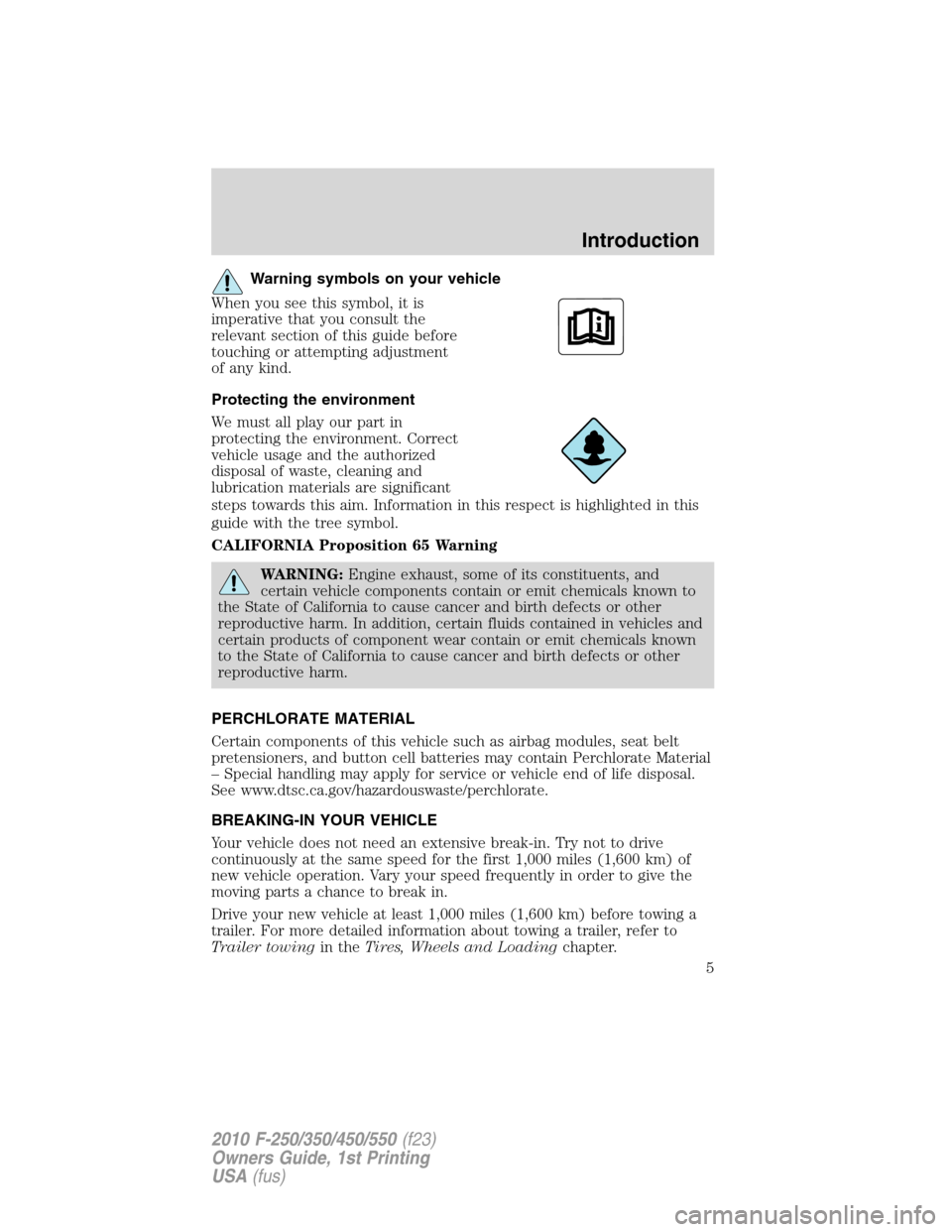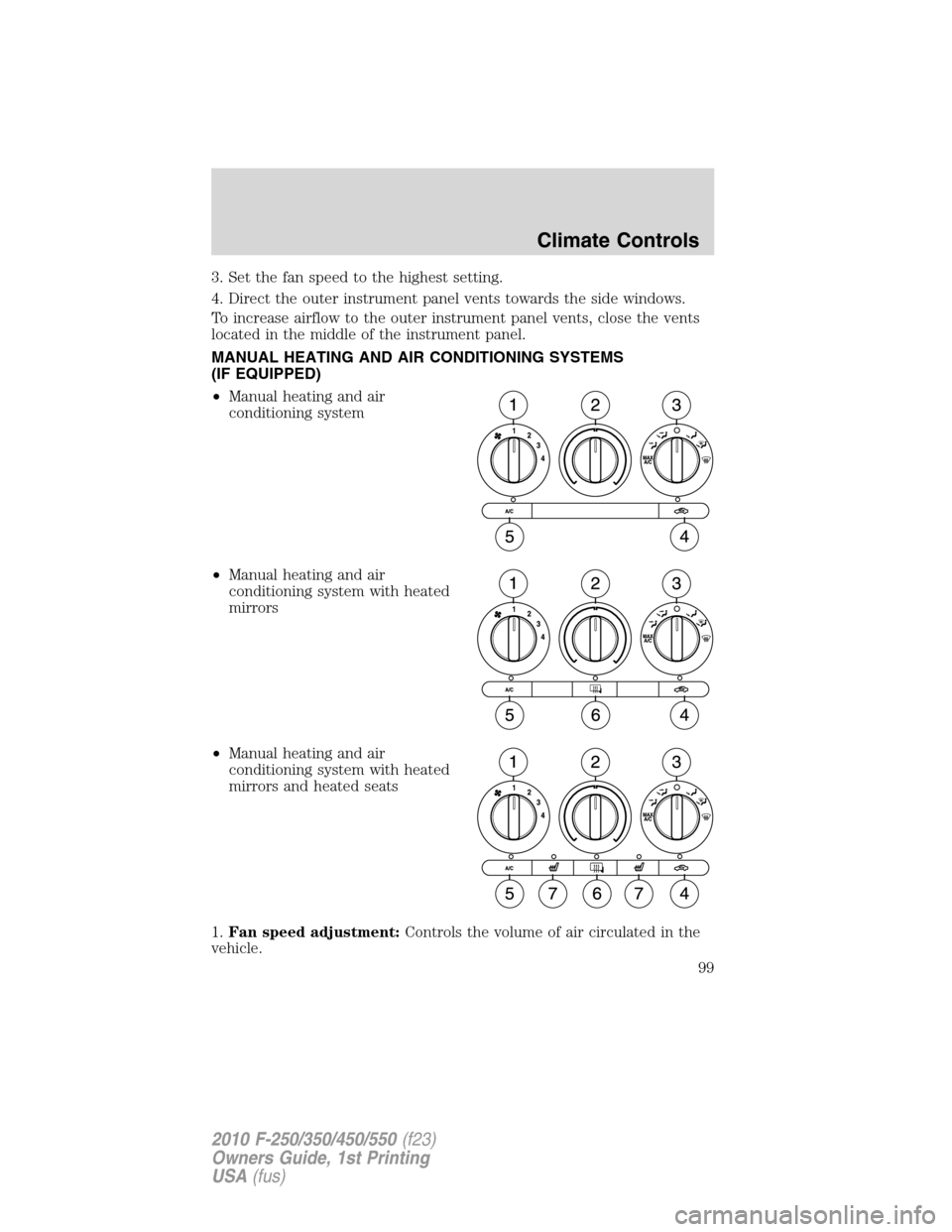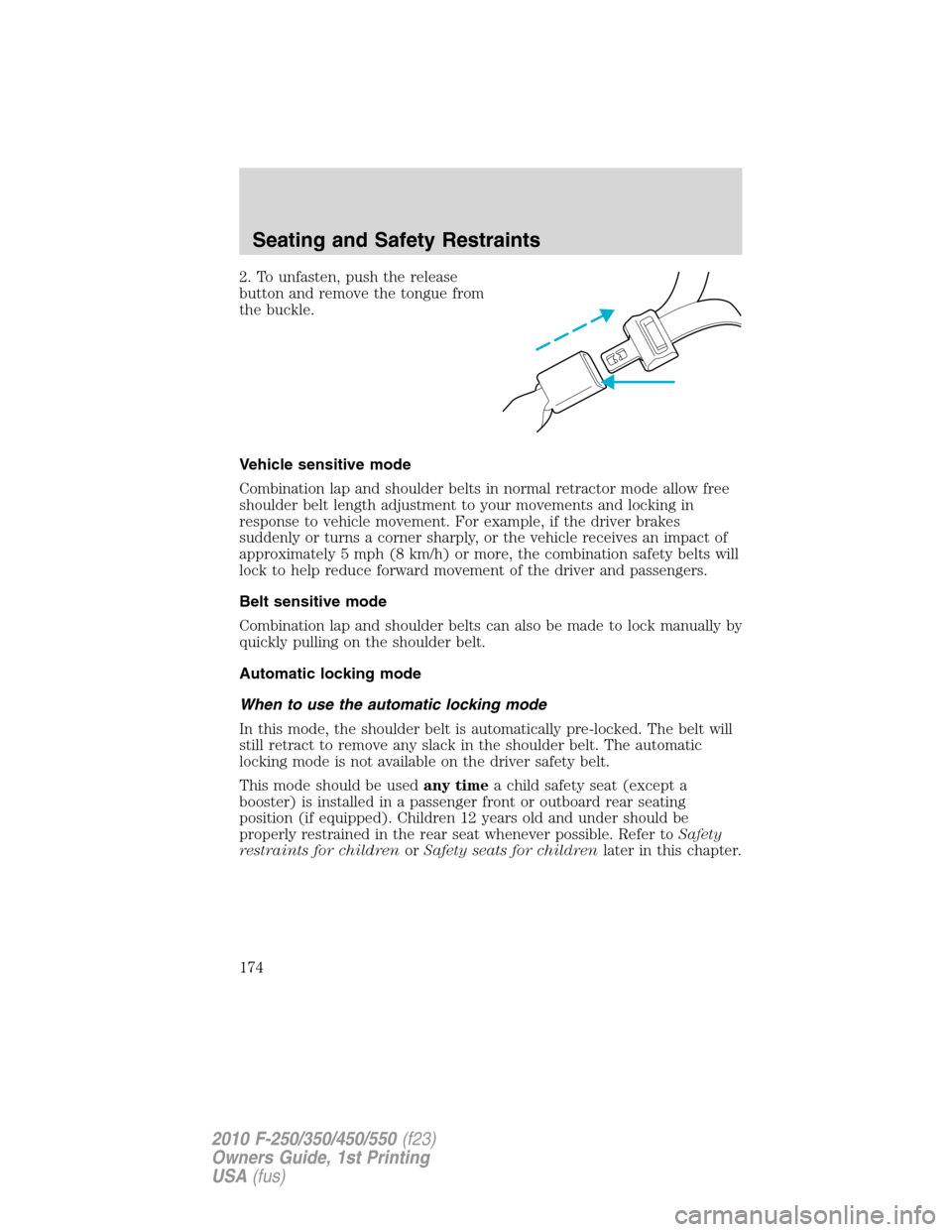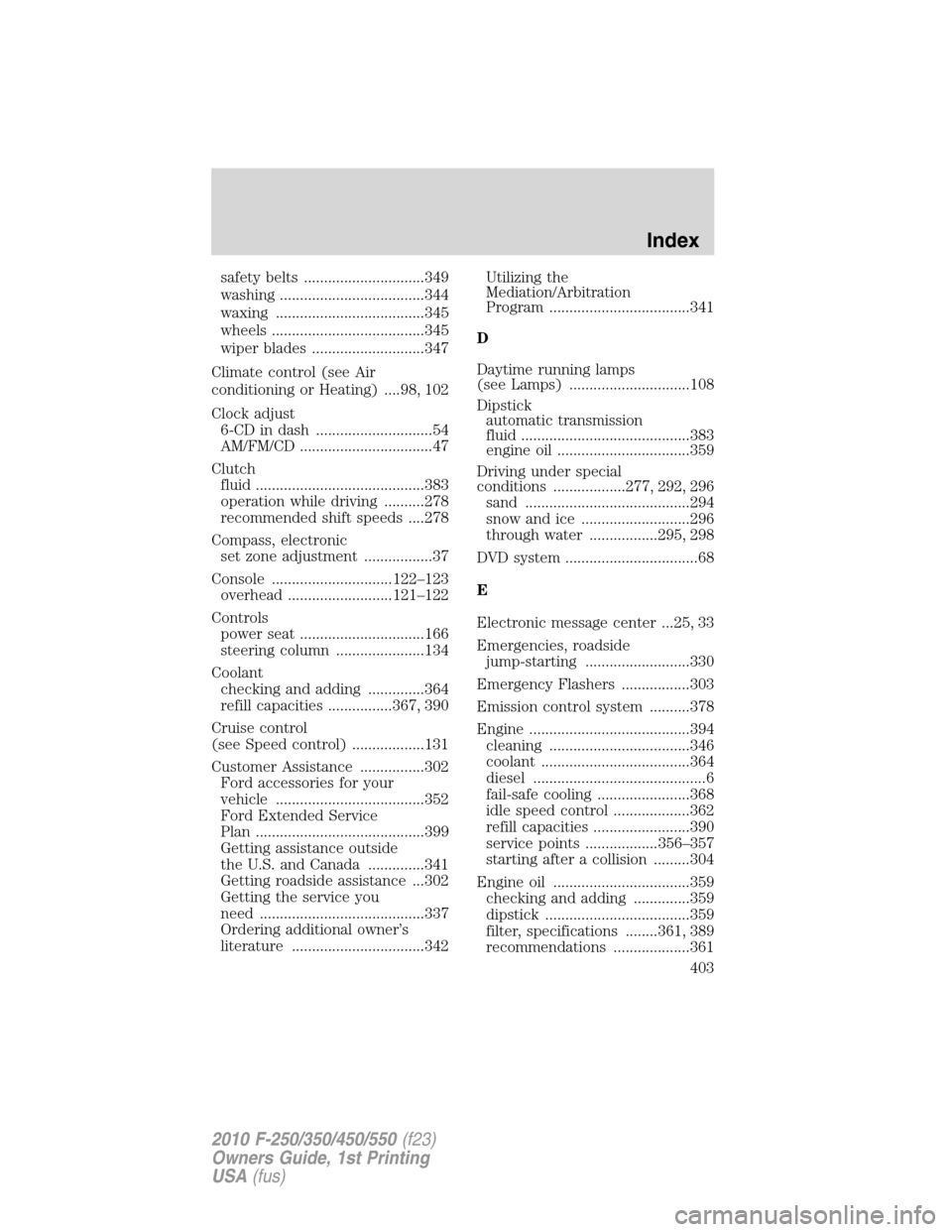2010 FORD SUPER DUTY seat adjustment
[x] Cancel search: seat adjustmentPage 5 of 407

Warning symbols on your vehicle
When you see this symbol, it is
imperative that you consult the
relevant section of this guide before
touching or attempting adjustment
of any kind.
Protecting the environment
We must all play our part in
protecting the environment. Correct
vehicle usage and the authorized
disposal of waste, cleaning and
lubrication materials are significant
steps towards this aim. Information in this respect is highlighted in this
guide with the tree symbol.
CALIFORNIA Proposition 65 Warning
WARNING:Engine exhaust, some of its constituents, and
certain vehicle components contain or emit chemicals known to
the State of California to cause cancer and birth defects or other
reproductive harm. In addition, certain fluids contained in vehicles and
certain products of component wear contain or emit chemicals known
to the State of California to cause cancer and birth defects or other
reproductive harm.
PERCHLORATE MATERIAL
Certain components of this vehicle such as airbag modules, seat belt
pretensioners, and button cell batteries may contain Perchlorate Material
– Special handling may apply for service or vehicle end of life disposal.
See www.dtsc.ca.gov/hazardouswaste/perchlorate.
BREAKING-IN YOUR VEHICLE
Your vehicle does not need an extensive break-in. Try not to drive
continuously at the same speed for the first 1,000 miles (1,600 km) of
new vehicle operation. Vary your speed frequently in order to give the
moving parts a chance to break in.
Drive your new vehicle at least 1,000 miles (1,600 km) before towing a
trailer. For more detailed information about towing a trailer, refer to
Trailer towingin theTires, Wheels and Loadingchapter.
Introduction
5
2010 F-250/350/450/550(f23)
Owners Guide, 1st Printing
USA(fus)
Page 98 of 407

HEATER ONLY SYSTEM
(IF EQUIPPED)
1.Fan speed adjustment:Controls
the volume of air circulated in the
vehicle.
2.Temperature selection:
Controls the temperature of the
airflow in the vehicle.
3.Air flow selections:Controls the direction of the airflow in the
vehicle. See the following for a brief description on each control.
:Distributes outside air through the instrument panel vents.
:Distributes outside air through the instrument panel vents and the
floor vents.
(OFF):Outside air is shut out and the climate system is turned off.
:Distributes outside air through the floor vents.
:Distributes outside air through the windshield defroster vents and
floor vents.
:Distributes outside air through the windshield defroster vents and
demister vents. Can be used to clear the windshield of fog and thin ice.
Operating tips
•To reduce fog build up on the windshield during humid weather, place
the air flow selector in the
position.
•Do not put objects under the front seats that will interfere with the air
flow to the back seats.
•To reduce humidity build-up inside the vehicle, do not drive in
the
(OFF) position.
•Under normal weather conditions, do not leave the airflow selector
in
(OFF). This allows the vehicle to breathe using the outside air
inlets.
•Remove any snow, ice or leaves from the air intake area at the base of
the windshield.
To aid in side window defogging/demisting in cold weather:
1. Select
.
2. Adjust the temperature control to maintain comfort.
Climate Controls
98
2010 F-250/350/450/550(f23)
Owners Guide, 1st Printing
USA(fus)
Page 99 of 407

3. Set the fan speed to the highest setting.
4. Direct the outer instrument panel vents towards the side windows.
To increase airflow to the outer instrument panel vents, close the vents
located in the middle of the instrument panel.
MANUAL HEATING AND AIR CONDITIONING SYSTEMS
(IF EQUIPPED)
•Manual heating and air
conditioning system
•Manual heating and air
conditioning system with heated
mirrors
•Manual heating and air
conditioning system with heated
mirrors and heated seats
1.Fan speed adjustment:Controls the volume of air circulated in the
vehicle.
Climate Controls
99
2010 F-250/350/450/550(f23)
Owners Guide, 1st Printing
USA(fus)
Page 174 of 407

2. To unfasten, push the release
button and remove the tongue from
the buckle.
Vehicle sensitive mode
Combination lap and shoulder belts in normal retractor mode allow free
shoulder belt length adjustment to your movements and locking in
response to vehicle movement. For example, if the driver brakes
suddenly or turns a corner sharply, or the vehicle receives an impact of
approximately 5 mph (8 km/h) or more, the combination safety belts will
lock to help reduce forward movement of the driver and passengers.
Belt sensitive mode
Combination lap and shoulder belts can also be made to lock manually by
quickly pulling on the shoulder belt.
Automatic locking mode
When to use the automatic locking mode
In this mode, the shoulder belt is automatically pre-locked. The belt will
still retract to remove any slack in the shoulder belt. The automatic
locking mode is not available on the driver safety belt.
This mode should be usedany timea child safety seat (except a
booster) is installed in a passenger front or outboard rear seating
position (if equipped). Children 12 years old and under should be
properly restrained in the rear seat whenever possible. Refer toSafety
restraints for childrenorSafety seats for childrenlater in this chapter.
Seating and Safety Restraints
174
2010 F-250/350/450/550(f23)
Owners Guide, 1st Printing
USA(fus)
Page 177 of 407

Front safety belt height adjustment
The front outboard seating positions are equipped with safety belt height
adjusters.
Adjust the height of the shoulder belt so the belt rests across the middle
of your shoulder.
WARNING:Position the safety belt height adjusters so that the
belt rests across the middle of your shoulder. Failure to adjust
the safety belt properly could reduce the effectiveness of the seat belt
and increase the risk of injury in a collision.
To adjust the shoulder belt height,
push the button and slide the height
adjuster up or down. Release the
button and pull down on the height
adjuster to make sure it is locked in
place.
Safety belt with cinch tongue (Regular cab center seating position
and Super Cab/Crew Cab rear center seating positions)
The cinch tongue will slide up and down the belt webbing when the belt
is stowed or while putting safety belts on. When the lap/shoulder safety
belt is buckled, the cinch tongue will allow the lap portion to be
shortened, but pinches the webbing to keep the lap portion from getting
longer. The cinch tongue is designed to slip during a crash, so always
wear the shoulder belt properly and don’t allow any slack in either the
lap or shoulder portions.
Before you can reach and latch a combination lap and shoulder belt
having a cinch tongue into the buckle, you may have to lengthen the lap
belt portion of it.
Seating and Safety Restraints
177
2010 F-250/350/450/550(f23)
Owners Guide, 1st Printing
USA(fus)
Page 403 of 407

safety belts ..............................349
washing ....................................344
waxing .....................................345
wheels ......................................345
wiper blades ............................347
Climate control (see Air
conditioning or Heating) ....98, 102
Clock adjust
6-CD in dash .............................54
AM/FM/CD .................................47
Clutch
fluid ..........................................383
operation while driving ..........278
recommended shift speeds ....278
Compass, electronic
set zone adjustment .................37
Console ..............................122–123
overhead ..........................121–122
Controls
power seat ...............................166
steering column ......................134
Coolant
checking and adding ..............364
refill capacities ................367, 390
Cruise control
(see Speed control) ..................131
Customer Assistance ................302
Ford accessories for your
vehicle .....................................352
Ford Extended Service
Plan ..........................................399
Getting assistance outside
the U.S. and Canada ..............341
Getting roadside assistance ...302
Getting the service you
need .........................................337
Ordering additional owner’s
literature .................................342Utilizing the
Mediation/Arbitration
Program ...................................341
D
Daytime running lamps
(see Lamps) ..............................108
Dipstick
automatic transmission
fluid ..........................................383
engine oil .................................359
Driving under special
conditions ..................277, 292, 296
sand .........................................294
snow and ice ...........................296
through water .................295, 298
DVD system .................................68
E
Electronic message center ...25, 33
Emergencies, roadside
jump-starting ..........................330
Emergency Flashers .................303
Emission control system ..........378
Engine ........................................394
cleaning ...................................346
coolant .....................................364
diesel ...........................................6
fail-safe cooling .......................368
idle speed control ...................362
refill capacities ........................390
service points ..................356–357
starting after a collision .........304
Engine oil ..................................359
checking and adding ..............359
dipstick ....................................359
filter, specifications ........361, 389
recommendations ...................361
Index
403
2010 F-250/350/450/550(f23)
Owners Guide, 1st Printing
USA(fus)